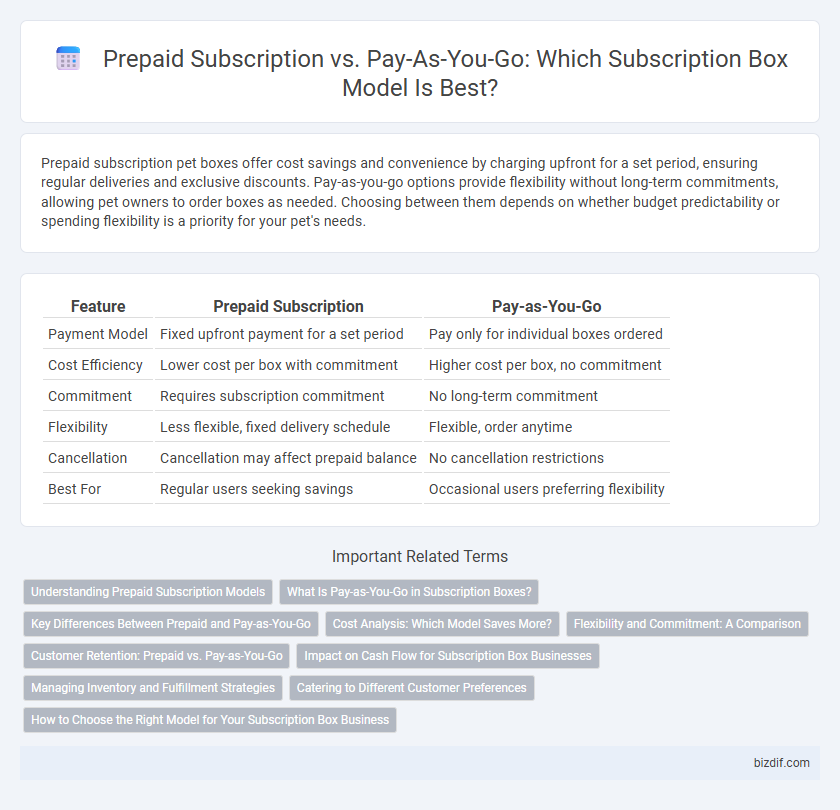Prepaid subscription pet boxes offer cost savings and convenience by charging upfront for a set period, ensuring regular deliveries and exclusive discounts. Pay-as-you-go options provide flexibility without long-term commitments, allowing pet owners to order boxes as needed. Choosing between them depends on whether budget predictability or spending flexibility is a priority for your pet's needs.
Table of Comparison
| Feature | Prepaid Subscription | Pay-as-You-Go |
|---|---|---|
| Payment Model | Fixed upfront payment for a set period | Pay only for individual boxes ordered |
| Cost Efficiency | Lower cost per box with commitment | Higher cost per box, no commitment |
| Commitment | Requires subscription commitment | No long-term commitment |
| Flexibility | Less flexible, fixed delivery schedule | Flexible, order anytime |
| Cancellation | Cancellation may affect prepaid balance | No cancellation restrictions |
| Best For | Regular users seeking savings | Occasional users preferring flexibility |
Understanding Prepaid Subscription Models
Prepaid subscription models require customers to pay upfront for a set period or number of deliveries, ensuring predictable revenue and customer commitment. These models often include discounts or exclusive offers, enhancing value perception and customer retention. Unlike pay-as-you-go plans, prepaid subscriptions reduce the risk of churn and streamline inventory management for subscription box businesses.
What Is Pay-as-You-Go in Subscription Boxes?
Pay-as-you-go subscription boxes allow customers to purchase one-off boxes without committing to a recurring plan, providing flexibility and control over spending. This model attracts buyers who prefer to try products before subscribing or who want occasional deliveries without long-term contracts. Unlike prepaid subscriptions, pay-as-you-go options eliminate upfront bulk payments, appealing to budget-conscious consumers seeking low-risk purchasing.
Key Differences Between Prepaid and Pay-as-You-Go
Prepaid subscriptions require users to pay upfront for a fixed period or number of boxes, offering a predictable cost structure and often discounted rates. Pay-as-you-go models bill customers based on each individual box or delivery, providing greater flexibility without long-term commitment but potentially higher costs per box. The key differences lie in payment timing, commitment level, and pricing predictability, affecting user budgeting and subscription management.
Cost Analysis: Which Model Saves More?
Prepaid subscription models often provide cost savings through discounted rates and bundled services, making them ideal for consistent users seeking budget predictability. Pay-as-you-go plans offer flexibility without upfront commitments but may lead to higher expenses due to variable usage fees and lack of discounts. Analyzing usage patterns and frequency is crucial to determine which model minimizes overall costs effectively.
Flexibility and Commitment: A Comparison
Prepaid subscription boxes offer a fixed payment upfront, ensuring consistent delivery and often discounted prices, but require a commitment that limits flexibility. Pay-as-you-go subscription boxes allow users to order on demand without long-term obligations, providing greater freedom to pause or cancel anytime. This flexibility appeals to consumers seeking personalized control over spending and delivery frequency without being tied to ongoing contracts.
Customer Retention: Prepaid vs. Pay-as-You-Go
Prepaid subscriptions consistently enhance customer retention by securing upfront commitment and providing users with a sense of value through bundled benefits and discounts. Pay-as-you-go models offer flexibility but often lead to higher churn rates due to the absence of long-term obligation and reduced incentive for continued engagement. Data from subscription services reveal that prepaid plans can increase retention by up to 30% compared to pay-as-you-go options, emphasizing their effectiveness in sustaining customer loyalty.
Impact on Cash Flow for Subscription Box Businesses
Prepaid subscriptions provide immediate cash flow, allowing subscription box businesses to invest upfront in inventory and marketing, reducing financial uncertainty. Pay-as-you-go models distribute revenue over time, resulting in steadier but slower cash inflow that may challenge inventory purchasing and operational expenses. Optimizing the balance between prepaid and pay-as-you-go options can enhance cash flow management and sustain business growth.
Managing Inventory and Fulfillment Strategies
Prepaid subscription models enable better inventory planning and streamlined fulfillment by providing predictable order volumes and upfront payment data, reducing stockouts and overstock risks. Pay-as-you-go systems require flexible inventory management to accommodate fluctuating demand, often leading to higher holding costs and reactive supply chain adjustments. Optimizing fulfillment strategies hinges on accurate demand forecasting, with prepaid subscriptions facilitating bulk procurement and faster dispatch, while pay-as-you-go demands dynamic logistics to maintain customer satisfaction.
Catering to Different Customer Preferences
Prepaid subscriptions offer customers fixed, upfront payments providing convenience and potential savings, appealing to those who prefer budgeting and commitment. Pay-as-you-go models provide flexibility, attracting customers who value control over spending and want to avoid long-term obligations. Catering to these preferences allows subscription box businesses to reach a broader audience by aligning payment structures with consumer behavior.
How to Choose the Right Model for Your Subscription Box Business
Selecting the right payment model for your subscription box business depends on customer preferences and cash flow management. Prepaid subscription models ensure predictable revenue and reduce churn by charging customers upfront for a fixed period, while pay-as-you-go offers flexibility and appeals to customers hesitant to commit long-term. Analyze your target market's buying behavior and evaluate retention rates to determine the optimal balance between customer acquisition and steady income.
Prepaid subscription vs Pay-as-you-go Infographic

 bizdif.com
bizdif.com